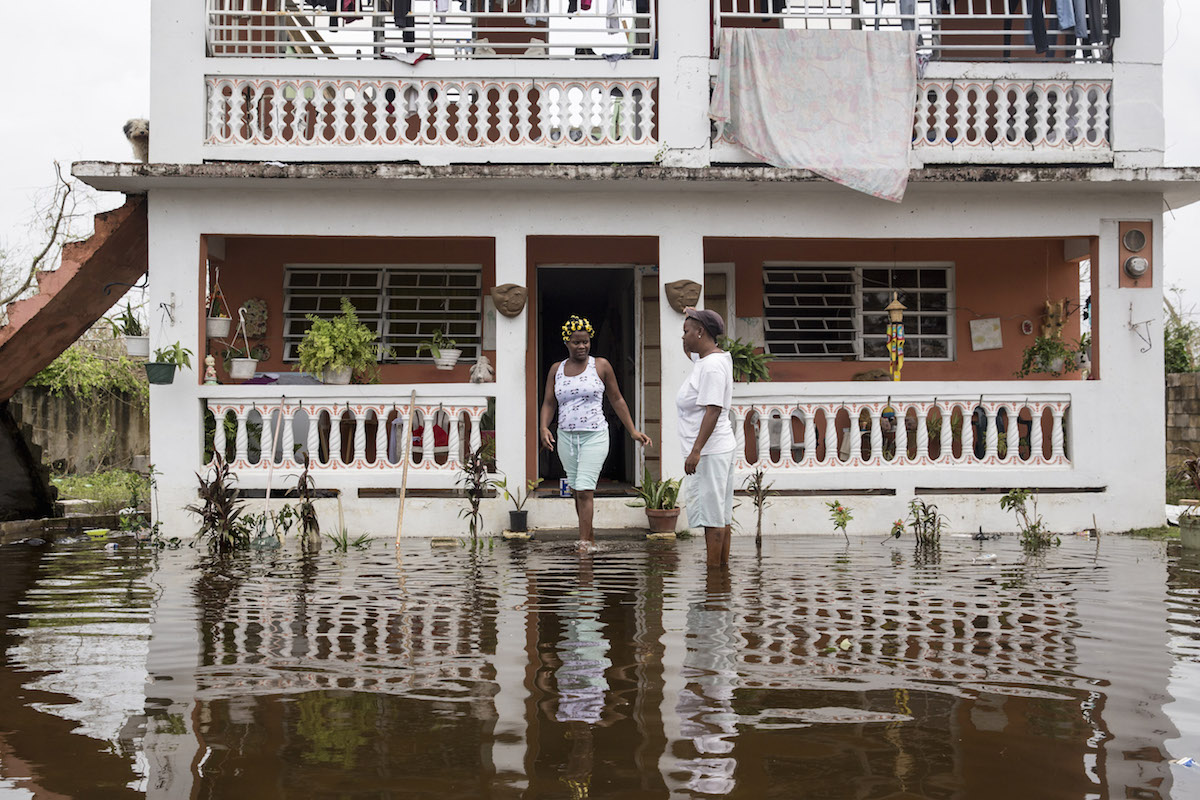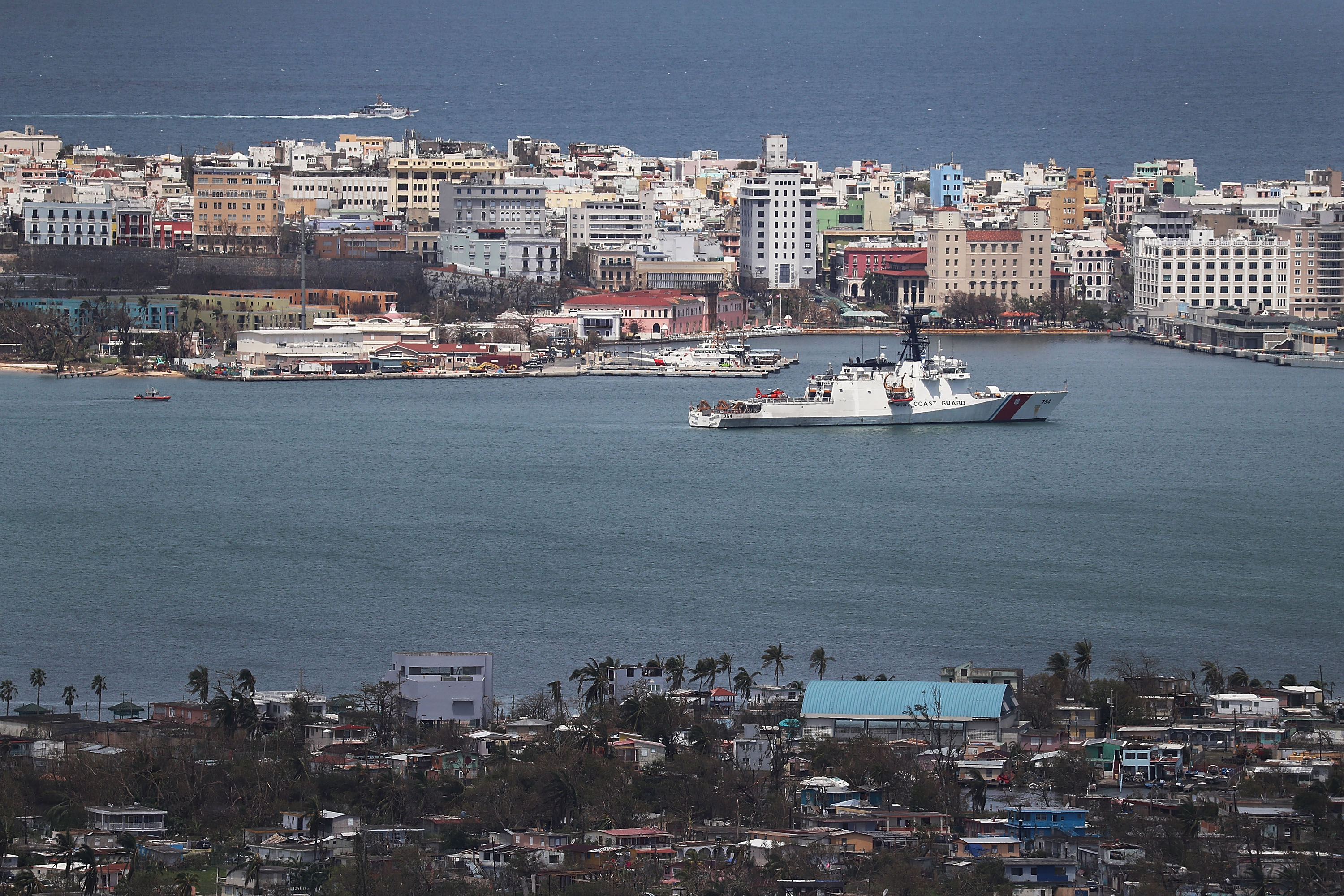Cows and horses lie dead on the side of roads. Many streets are now rivers. Flowing through them are the remnants of roofs. Hundreds of houses have become nothing more than rubble. Farms flattened. Yam, plantain, sweet pepper and banana crops lie lifeless; they were uprooted by landslides. The barks of leafless trees loll on shattered highways. Toppled beside them are traffic lights, street signs, telecommunication towers and power lines. Families, including elders holding oxygen machines and crying children, tread through muddy, likely contaminated, waters. “SOS” is scrawled on a dry but desolate street.
This is post-Hurricane Maria Puerto Rico, the United States’ paradise colony. And because of its status, the Caribbean archipelago – home to 3.4 million people – may not receive the aid it needs.
Since the category four hurricane ravaged Puerto Rico last week, 16 people have been confirmed dead, 1.5 million residents lack potable water, and 100 percent of the country was left without power. The situation has been described as “apocalyptic” and “catastrophic.” Yet, the federal government has been slow to respond, but quick to impede aid from other countries trying to help Puerto Rico. This is what emergency and disaster relief looks like for US colonies, or, as the federal government prefers to describe it, a “commonwealth,” “unincorporated territory,” or “free associated state.”

Puerto Rico has been a US colony since 1898, when the northern country invaded and seized the island as part of the Spanish-American War. After almost two decades in political limbo, in 1917, the U.S. Congress passed the Jones-Shafroth act, which gave Puerto Ricans a second-class kind of citizenship, one where they were able to serve in the U.S. military, with nearly 20,000 immediately deployed to fight in World War I, but not able to vote for the president or elect voting senators or representatives in the U.S. Congress.
Since establishing colonial rule over the island, the outcome has been disastrous, especially for its economy. In 1920, for instance, the US introduced the Jones Act (not to be confused with the Jones-Shafroth Act), regulation that required all goods shipped between US ports to be transported on a vessel that is US-built, US-owned, and US-manned. In Puerto Rico, this means it must use expensive protected ships, making goods there needlessly pricey. In fact, products sold in Puerto Rico are often double what they fare in the US mainland, making the price of living on the island 13 percent higher than in 325 urban areas in the contiguous US. Meanwhile, the per capita income in Puerto Rico is $18,000, almost half that of Mississippi, the poorest US state. The adverse shipping law, along with Congress’ insufficient Medicare reimbursements and Puerto Rico’s favorable tax treatment for investors, also contributed to the territory’s $72 billion “unpayable” debt.
More recently, the Puerto Rico Oversight Management and Economic Stability (PROMESA) Act – a controversial law signed by former President Barack Obama in 2016 to supposedly help Puerto Rico’s economic crisis – established a seven-member board of non-elected officials to control the island’s spending and restructure its massive debt load. In other words, Puerto Rico lost the already-restricted power it had to steer its economy, deepening its colonial relationship with the US. As if that alone wasn’t nefarious, the board has not offered any real solutions to the island’s problems. Rather than addressing the roots of Puerto Rico’s economic troubles, La Junta, as the board is scathingly called on the island, has instead concentrated on short-term austerity measures that directly harm the Puerto Rican people, including increasing taxes on the working poor, cutting wages, closing hundreds of schools, and educational programs, as well as providing tax breaks to entice US investors.
With its sovereignty ripped away, Puerto Rico is less equipped to prepare for natural, or man-made, disasters and more prone to experiencing massive damages. According to a 2012 Asia-Pacific Disaster Report, the risk of catastrophe is determined by a physical hazard exposure (how close it is to a threat) and its social vulnerability (how resilient it is to that physical peril).
Before Hurricane Maria hit, already 45.5 percent of islanders lived below the poverty line, making the purchase of high-priced essentials like water, food, and medicine difficult and life-saving items like hurricane-resilient roofs, storm shutters, and solar generators unfeasible. Infrastructurally, the island was also vulnerable. Roads, bridges, and power supplies had already been deteriorating before the hurricane. PREPA, the island’s utility provider, had filed for bankruptcy in July. Predictably, Maria’s 150-mph wind gusts demolished much of this infrastructure, including three-quarters of PREPA’s supplies. Even more, with island-wide school closings, only 329 facilities were able to shelter people during the storm versus the 372 that opened its doors during Hurricane Bertha in 2014.

Puerto Rico’s colonial status will likely also engender a poor and protracted recovery. To start, FEMA assistance in Puerto Rico has been insubstantial. Response personnel are currently only providing help with search and rescue, public health and safety, and debris removal. There are no present efforts on rebuilding or even restoring power. As for La Junta, which has so far been silent, it will likely use the devastation to push for privatizing the operation of public services, including PREPA. Even more, as the island’s massive humanitarian crisis became clear over the weekend, President Donald Trump did not weigh in on the calamity. Instead, the commander-in-chief was on Twitter attacking athletes protesting white supremacy and racial injustice.
In fact, it took Trump five days to respond, and when he did, he blamed the devastation on the island’s faulty infrastructure and reminded the people that they still had a debt to pay. Trump, briskly criticized for his neglect of Puerto Rico, announced that he would be visiting the island next week. By then, millions of starving and homeless islanders will have fought desperately to survive for nearly two weeks.
As Puerto Ricans cope with insufficient aid from the federal government, the Jones Act drastically stalled help from foreign countries. The governments of Cuba and Venezuela offered Puerto Rico hurricane relief, but the act prevented them from zooming over aid supplies. Any foreign country that wants to help must first pay tariffs for landing at a US port or drop off their goods with a Puerto Rico-bound US ship in Florida. While it’s common for the White House to temporarily lift the Jones Act during natural disasters, as Trump did in Texas and Florida in August for hurricanes Harvey and Irma, he initially refused to waive the antiquated statute for Puerto Rico. Despite pleas from members of Congress, including Rep. Nydia Velázquez (D-NY) and Sen. John McCain (R-AZ), Trump on Wednesday said he would not forgo the act because there are “a lot of people that work in the shipping industry that don’t want the Jones Act lifted.” It wasn’t until Thursday – after widespread anger and many calling elected officials to put pressure on the government – that Trump finally temporarily suspended the Jones Act.
But his initial reaction was to prioritize the pockets of a few on the mainland over the lives and health of 3.4 million so-called “US citizens” on the island. For anyone curious about what colonialism looks like, this is it – contributing to catastrophic disasters and, when it strikes, leaving millions of mostly black and brown people homeless, malnourished and dying. It’s leaving them to fend for themselves.







